The Royal Mail Line ‘Three Graces’
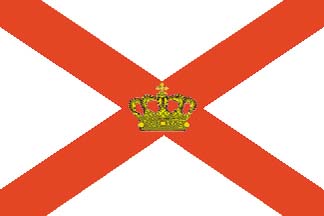 This trio of Royal Mail Line split superstructure white hulled passenger and cargo ships was completed in 1959/60, but had only eleven years of service in the South American and New Zealand trades, followed by remarkable conversions into car carriers to give another eleven years of service with Hoegh-Ugland Auto Liners of Oslo. They were 18 knot motorships completed by Harland & Wolff Ltd. at Belfast as Yard numbers 1594, 1595 and 1596 to replace both Royal Mail Line’s former ‘A’ Class sailings from Southampton and the ‘Highland’ class sailings from London to Buenos Aires. They represented the largest single order for the Belfast yard in post-war years at a combined contract price of £12.6 million. The rationale behind retaining the split superstructure of traditional Royal Mail Line and Nelson Line passenger and cargo ships was that a detached long flying bridge would improve the visibility astern for the navigating officers. More importantly, it permitted the hatch for number three hold to be in the centre of the large cargo spaces, as the chilled beef carcasses were suspended from numerous deck head rails in the low headroom insulated spaces.
This trio of Royal Mail Line split superstructure white hulled passenger and cargo ships was completed in 1959/60, but had only eleven years of service in the South American and New Zealand trades, followed by remarkable conversions into car carriers to give another eleven years of service with Hoegh-Ugland Auto Liners of Oslo. They were 18 knot motorships completed by Harland & Wolff Ltd. at Belfast as Yard numbers 1594, 1595 and 1596 to replace both Royal Mail Line’s former ‘A’ Class sailings from Southampton and the ‘Highland’ class sailings from London to Buenos Aires. They represented the largest single order for the Belfast yard in post-war years at a combined contract price of £12.6 million. The rationale behind retaining the split superstructure of traditional Royal Mail Line and Nelson Line passenger and cargo ships was that a detached long flying bridge would improve the visibility astern for the navigating officers. More importantly, it permitted the hatch for number three hold to be in the centre of the large cargo spaces, as the chilled beef carcasses were suspended from numerous deck head rails in the low headroom insulated spaces.
The good looking trio were known as ‘The Three Graces’, in the manner of the representation of three beautiful daughters of the god Zeus as painted by Jean-Baptiste Regnault and sculpted by Antonio Canova. Their beauty, charm and joy were legendary and they were present at banquets to entertain and delight the guests of Aphrodite (Venus), the goddess of love and beauty. Royal Mail Line gave this trio of combination passenger and cargo ships traditional ‘river’ or ‘Spanish provinces and cities’ names e.g. Asturias, Alcantara, Almanzora and others with Edwardian style interiors, but a case could also be made for the names to commemorate the legendary female Amazon warrior tribe of Greek mythology, and the women of the Spanish provinces of Aragon and Arlanza in northern Spain. Arlanza is an ancient Spanish province, the river Arlanzon today running through the main town of Burgos in Castilla y Leon province.
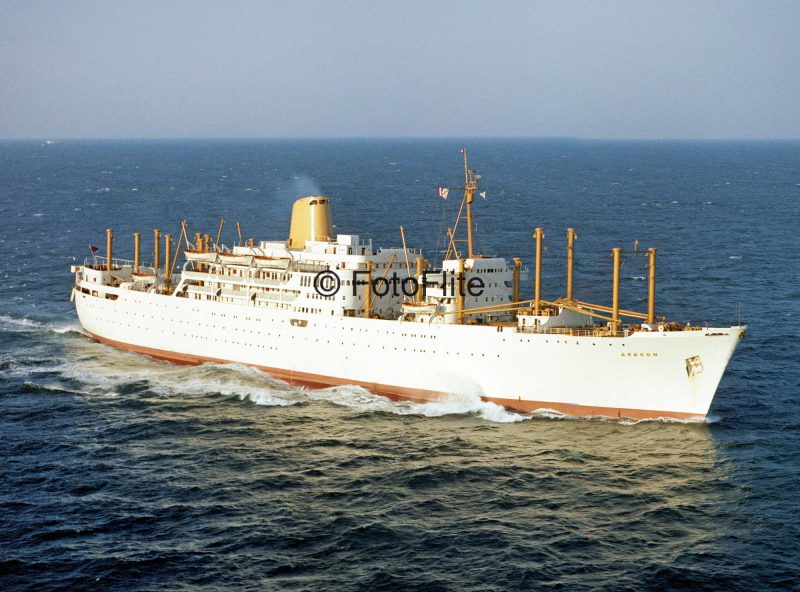
Amazon was the third ship of that name in the Royal Mail Line fleet, Aragon was the second of that name, and Arlanza was the second of that name. The first Amazon had the shortest career ever in the company after completion at Blackwall at the end of 1851. She sailed on her maiden voyage from Southampton on 2nd January 1852 but sank on fire off Portland Bill a day later with the loss of 36 passengers and 68 crew members, including all of her officers and two midshipmen. Amazon (2) was of 10,037 grt and was a combination passenger and cargo ship built by Harland & Wolff Ltd. at Belfast in 1906 with accommodation for one thousand passengers. She was torpedoed and sunk by U52 on 15th March 1918 off the north coast of Ireland while outward bound from Liverpool, all were saved, and the U boat was destroyed by an escort. The first Aragon was her sister and she was torpedoed and sunk on 30th December 1917 while operating as a troopship at Alexandria with the loss of 610 troops and crew members. She had entered the harbour but found no berth and was ordered out into the roadstead where she was promptly sunk, together with a destroyer that was rescuing survivors. The first Arlanza of 15,044 grt had a much longer career after completion at Belfast in 1912 with accommodation for 1,390 passengers in three classes. After a career including service as an Armed Merchant Cruiser (AMC) she was broken up at Blyth at the end of 1938.
Design And Specification Of ‘The Three Graces’
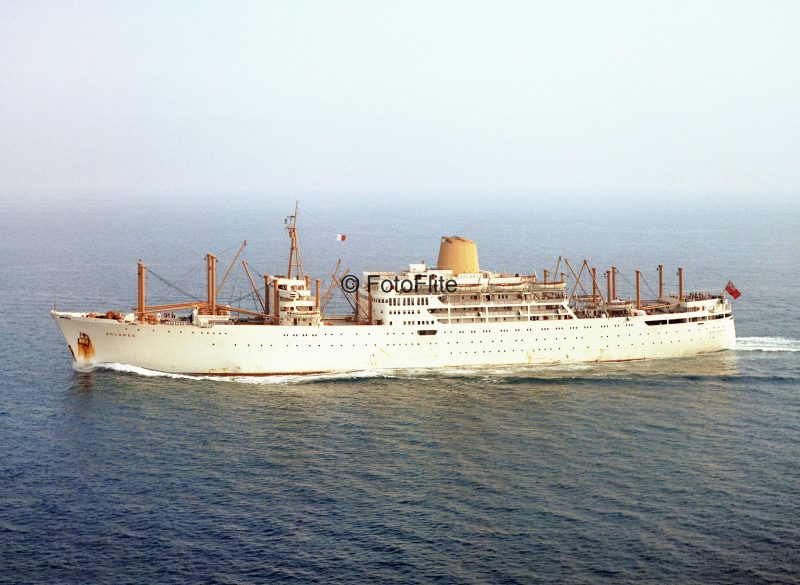
The trio were given well raked and slightly curved bows, cruiser sterns, tripod signalling masts, and a single funnel of distinctive design. The traditional three class passenger design was retained even at this late date of 1958/59 when formal class separation was beginning to disappear. There were four complete steel decks in ‘B’, ‘C’, ‘D’ and ‘E’ decks, plus lower and orlop decks forward and aft of the engine room, as well as the open or partly open Lido, Boat and Observation Decks above. There were eight watertight bulkheads to give good transverse subdivision, and there were three holds forward and two aft sets of orlop and lower ‘tween deck insulated spaces. There were ten lifeboats, with six on the main superstructure, two on the detached navigating bridge, and two aft.
The accommodation was arranged for 107 First Class passengers on ‘A’, ‘B’ and ‘C’ decks, while 82 Cabin Class passengers were given cabins on ‘B’, ‘C’, and ‘D’ decks, and 275 Third Class passengers were in cabins on ‘D’ and ‘E’ decks, giving a passenger complement of 464 and a crew of around 220. First Class had a maximum of three persons per cabin, while Cabin Class and Third Class had a maximum of four persons per cabin. The First Class public rooms included the First Class Lounge, First Class Gallery, First Class Smoking Room and First Class lido cafe and swimming pool on Lido Deck, and the First Class Dining Room on ‘C’ Shelter Deck, as well as other amenities such as covered verandah promenades, ladies and gentlemen hairdressing salons, children’s playroom and paddling pool, and a well stocked shop. The separate Cabin Class public rooms comprised the Cabin Class Restaurant on ‘C’ Shelter Deck, and the Cabin Class Lounge, Library, Writing Room, and Cocktail Bar on ‘B’ Lower Promenade Deck. Third Class public rooms comprised a restaurant, lounge, smoking room, bar, barber’s shop, well stocked library, children’s playroom and paddling pool and open air swimming pool.
The hull dimensions were length 583.0 feet, moulded beam of 78.0 feet, and depth from ‘A’ Deck to load line of 44.0 feet. The gross tonnage was 20,360 and the net tonnage 11,100. The cargo spaces held around 4,500 tonnes of chilled meat, with a small proportion of this available for the carriage of fruit and dairy produce as seasonal demands required. Two of these chambers produced a lower constant temperature of minus five degrees. The cargo handling outfit on nine sets of posts comprised two 15 tonne, four 10 tonne, two 7 tonne and twelve 5 ton derricks, with twenty Clarke Chapman electric cargo winches, electric windlass, four electric capstans, and electro-hydraulic steering gear. The trio were fully stabilised and air conditioned, and the general decor of the public rooms of the trio was traditional brown or light panelling blended with good use of modern plastics. The facilities on the eight passenger decks were arranged as follows:-
Observation Deck had tennis courts fore and aft and plenty of space that earlier migrants a century before could only have dreamt about, and accessed by both lifts and stairs.
Boat Deck had the First Class promenading spaces with six boats, three to port and three to starboard. Good views of the First Class swimming pool below from aft part of deck.
Lido Deck had the almost full width First Class Lounge forward with a large central dance floor and comfortable chairs, and the wrap around enclosed verandahs to port and starboard, again with comfortable chairs. The Lounge was convertible to a cinema and had blue flooring decorated with black diamonds and a large number of red, yellow and other coloured chairs. The central area of the deck had the First Class Gallery to starboard with brown panelling and three full size bookcases and a large map of the world, and the children’s playroom to port. Aft was the First Class Smoking Room, with well placed tables for parties of six, four, three and two, and which led aft to the open air Lido Cafe and the First Class swimming pool. Doors opened from the Smoking Room to cocktail rooms with curved bars and seating with slatted partitioning to both starboard and port. The good sized swimming pool had safety rails all around it, and was surrounded by many tables with gaily painted parasols.
Upper Promenade ‘A’ Deck had twelve De Luxe First Class cabins forward, eighteen First Class cabins in the central area, and the Cabin Class promenade spaces and swimming pool aft.
Lower Promenade ‘B’ Deck had the full width Cabin Class promenading space forward with the officers’ accommodation at the base of the detached bridge structure. The central area of the deck had 34 First Class and Cabin Class cabins with a well stocked shop, pantry, and ladies and gentlemen hair dressing salons. The Cabin Class Lounge aft had seating for sixty persons, with the Cabin Class Library to starboard and accessed from this lounge, and the Cabin Class Cocktail Bar to port and also accessed from this lounge. More Cabin Class space for promenading was at the stern of the vessels.
Shelter ‘C’ Deck had the magnificent First Class Dining Room forward with seating for all 107 passengers in one sitting. This room had plenty of space around large and small dining tables, yet by clever use of lighting maintained an easy and intimate atmosphere. The central area of the deck had the Main Entrance of the ship with the Purser’s Office on the forward side with the First Class Reception Room and eighteen First Class cabins forward again. Access to the Cabin Class Reception Room and Cabin Class Restaurant with seating for 112 passengers, and 45 Cabin Class cabins led aft from the Main Entrance. The officers’ restaurant was placed centrally with cabins for the Chief Steward and three or more stewards on the starboard side to serve the three restaurants.
Upper Deck ‘D’ and Lower Deck ‘E’ were the Third Class passenger decks with all of the cabins for the 275 passengers in four, three or two berth cabins.
Propelling And Other Machinery
The propelling machinery consisted of two Harland & Wolff six cylinder single acting two stroke cycle diesel engines of 17,000 bhp to give service speeds of eighteen knots at 114 rpm via twin Stone Manganese propellers. The cylinder diameter was 750 mm and the combined stroke 2,000 mm. They were fitted for burning heavy grade fuel oil, and diesel oil when required or for navigating in and out of port. Electrical energy was supplied from four diesel driven alternators, each set comprising a Harland & Wolff diesel engine and a Mather & Platt alternator with an output of 750 kilowatts, and an emergency and harbour use alternator was also fitted. Two vertical cylindrical thimble tube boilers were installed to burn fuel oil under natural draught, while two exhaust waste boilers took in the main engine exhaust gases and were fitted in the funnel.
The trio were equipped throughout with sound communication equipment supplied by Tannoy Marine Ltd. of London. The system served both passenger and crew accommodation, with control units situated in both the wheelhouse and the purser’s office. This provided for passenger entertainment, crew orders, Boat Deck orders, sea hailing, docking communications and general broadcasting. In addition to announcements and music, the system permitted gramophones, tape recorders, microphones and amplifiers to be plugged in at various points of the ships. The facility was available in First Class, Cabin Class and Third Class public rooms. A noteworthy feature was the ‘restoration’ system, which enabled general announcements to over-ride the local broadcasts or volume controls that were switched to the ‘off’ position. The equipment provided a safety feature in case of emergency or vessel evacuation when the immediate attention of all passengers was required. The trio had the latest Decca D7-TM909 main radars installed by Decca Radar Ltd. of London as well as the latest navigational aids on their bridges.
Careers Of The Trio
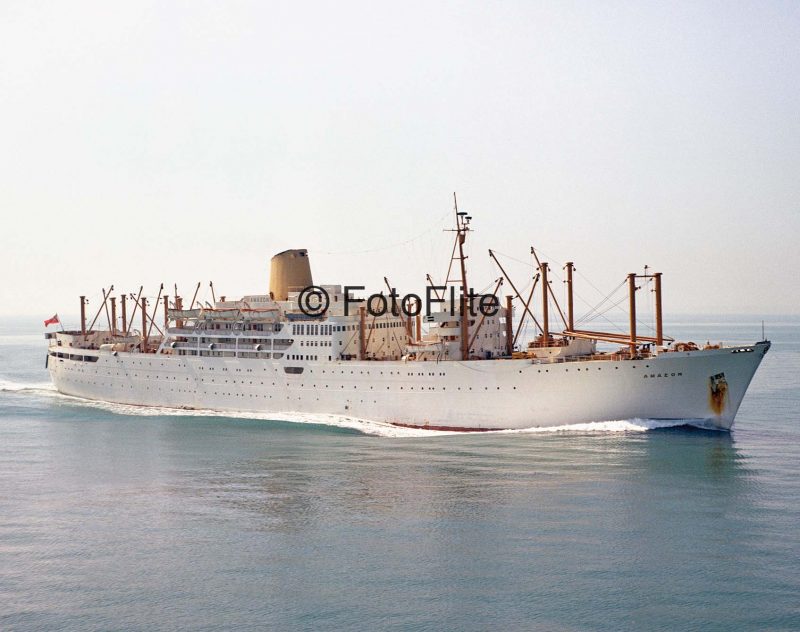
Amazon was launched by Princess Margaret on 7th July 1959 and completed on the last day of December, sailing on her maiden voyage on 22nd January from London to Rio de Janeiro and Buenos Aires with calls at Cherbourg, Vigo, Lisbon, Santos and Montevideo. She flew the white houseflag of Royal Mail Line with a red diagonal cross and a central golden crown. Aragon was launched from the Musgrave yard at Belfast on 20th October 1959 and completed in April 1960, sailing on her maiden voyage on 29th April 1960 from London on the same service. Arlanza was launched on 13th April 1960 at Belfast and completed in late September, sailing on her maiden voyage from London on 7th October 1960 on the same service. The voyage from London to Buenos Aires or vice-versa took twenty days, and Amazon completed three round voyages in just over six months, sailing on her second voyage from London on 1st April 1960 and on her third voyage southbound on 10th June 1960, and returning to London on 3rd August 1960. Thus, six round voyages could be made in just over a year, but allowing for an annual paint and refit, usually only five round voyages were made per annum.
The trio began to lose money after only five years of service, with sometimes only one quarter of their envisaged meat cargoes of 4,200 tonnes available homeward. Passenger income began to fall off as well when air travel began to serve both Brazil and Argentina from Europe. The Third Class accommodation was designed to be patronised by Portuguese and Spanish citizens emigrating to South America and embarking at Vigo and Lisbon. However, they made fewer and fewer outward and return voyages to and from these ports, with the few Third Class British travellers making the whole operation of passenger carrying unprofitable.
The Furness, Withy & Co. Ltd. owners of Royal Mail Line reluctantly made the decision to transfer the trio to the New Zealand trades of Shaw, Savill & Albion Co. Ltd. in 1968. Amazon was renamed Akaroa and sailed on her first voyage from Southampton to Australia and New Zealand on 28th May 1968. Aragon followed on 28th March 1969 as Aranda on her first voyage to the Antipodes, while Aragon took the famous Shaw, Savill & Albion Co. Ltd. name of Arawa on her 28th February 1969 voyage from Southampton to Australian and New Zealand ports. Aragon had closed out the South American service of Royal Mail Line on 20th February 1969 at Southampton. It was noticeable that their new names had almost the same number of letters of their original names, thus shortening the time and cost of altering all of their names on the bow, stern, bridge and lifeboats.
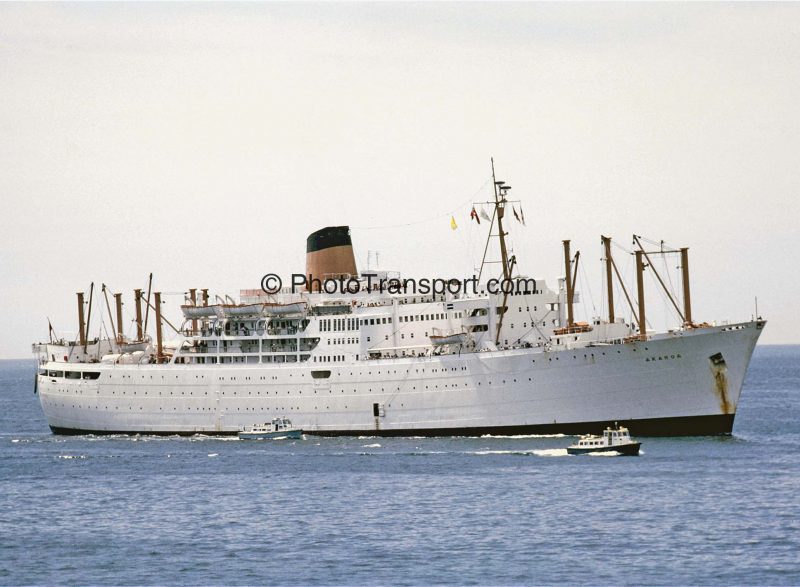
The trio had a short refit in London to become one class ships to the Antipodes. The voyages were usually of three month duration, sailing outwards via the Panama Canal and returning to London via the Panama Canal or via South Africa. Shaw, Savill & Albion Co. Ltd. had earlier separated passenger and cargo carrying in their fleet as uneconomic to carry both at the same time. The passenger liners Southern Cross of 1955 and Northern Star of 1962 had accommodation for a combined total of 2,572 one class passengers on Round the World voyages, so it became very difficult for Akaroa, Aranda and Arawa to compete with this pair with their much superior passenger facilities. The outcome had been predictable from 1968 when Furness, Withy & Co. Ltd. made the fateful (and wrong) decision to transfer the passenger and cargo trio to a trade that had earlier separated these functions.
The costs of annual refits and repainting of their white hulls was also a factor, with Akaroa having an accident with slight damage in March 1970 when entering the King George V Dry Dock in London for her annual refit. She slipped off the keel blocks of the dock when the water had been drained out of the dock to bilge level due the shore supports on the port side of the ship giving way. The dock had to be refilled with water to bring her fully upright again before restarting the draining of the dock again. After repair, Akaroa then suffered an engine room fire on her next voyage on 15th April 1970 when one thousand miles south west of the Azores. She drifted for some time until the engines were restarted and then eventually arrived in Barbados. The marine surveyors and the U.S. representative in Barbados checked her over before she was allowed to transit the Panama Canal, and she proceeded safely to New Zealand.
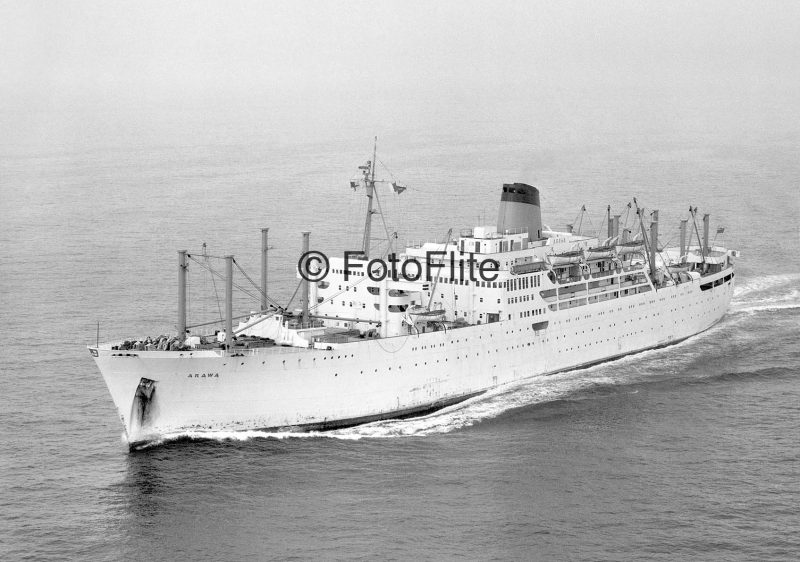
Conversions To Car Carriers
The uneconomic trio were sold to Leif Hoegh of Oslo and the Ugland family of Grimstad in Norway for the low combined sum of $700,000 in 1971. Hoegh-Ugland Auto Liners (HUAL) had been formed a year before in 1970, and the trio represented their first big venture into pure car carriers, having built many bulkers with temporary mezzanine car decks in the 1960s for the Pacific trades. Akaroa (ex Amazon) came under the ownership of A/S Ugland Rederi as Akarita, while Aranda (ex Aragon) and Arawa (ex Arlanza) came under the ownership of Leif Hoegh as Hoegh Traveller and Hoegh Transit respectively. Akarita was first sent to the Ugland owned yard of Nymo Mek Verksted at Grimstad for stripping of her accommodation. Hoegh Traveller and Hoegh Transit arrived at Rijeka in Croatia in the summer of 1971 to be rebuilt as car carriers by the Viktor Lenac Shipyard of the Brodogradiliste consortium. All of the original decks of the trio from the weather deck downwards were retained, with in addition five new long car decks built above the weather deck to give a remarkable rectangular box like appearance.

The drawings and specification details were drawn up by the shipyard to the owners requirements. The extensive work involved considerable ingenuity to find the maximum available space for four thousand cars. Hoegh Traveller was converted first, followed by Hoegh Transit and then Akarita in April 1972. The first step in the reconstruction involved stripping out all the insulation, pillars and hatch coamings on six decks forward of the machinery and two aft, together with all of the accommodation and store rooms forward and aft of the engine room. The decks were reinforced and strengthened with brackets to compensate for the removal of pillars and hatch trunks.
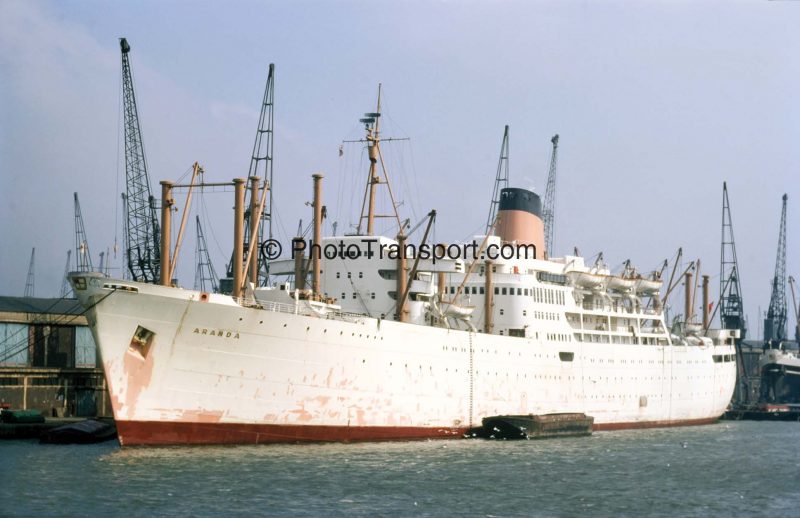
The accommodation on the Upper and Lower Promenade Decks (‘A’ and ‘B’) and the Lido Deck of the former First Class accommodation and public rooms was retained, and remodelled for the new crew of only forty persons. This involved renewal and modification of the sanitary, electrical, sprinkler and air conditioning systems. New refrigerated store rooms were built on Shelter ‘C’ deck, and new stairways, carbon dioxide rooms, and swimming pool were constructed on the aft part of the vessels. One of the waste heat exhaust boilers in the funnel was removed to provide space for shipping spare parts for the machinery to the engine room. The main diesel engines and auxiliary diesels and alternators were of course thoroughly overhauled.
A new steel superstructure was fabricated for the upper parts of the trio after removing all masts, derrick posts, hatch covers and the entire forward navigating bridge structure. In their place, five new car decks covered with marine plywood were erected, with the upper two levels of the separate structure forward i.e. the wheelhouse and the Master’s accommodation restored to the ship on the forward part of the new superstructure. The latter was extended aft to include the radio room and radio officer’s cabin, a new Master’s office and new switchboards and alarms. Cars were then able to be loaded and discharged only on the starboard side of the trio over hydraulically operated external ramps and side ports at ‘C’ deck level for the forward and aft car decks, and by mechanically operated side ports on ‘C’ and ‘D’ deck levels for the ‘midships car deck areas.
This ingenious conversion created a car deck space of 30,000 cubic metres for four thousand cars. The top of the new rectangular box like structure accommodated 46 axial supply and exhaust fans to provide up to 20 changes of air per hour to the car decks. Smoke detectors were fitted on all of the car decks with carbon dioxide flooding systems on the car decks and in the engine room. The stability of this top heavy structure was addressed by having 1,500 tonnes of concrete poured over the former tanktops of number two hold and the aft orlop spaces, as well as two waterline bolsters of length ninety metres and six metres high and 1.2 metres wide, into which excess water from collision damage or fire fighting on the car decks would pour, in order to maintain the stability of the ship. The length and beam remained unchanged, but the loaded draft of their lightweight cargo of cars was then 28.9 feet.
Careers As Car Carriers
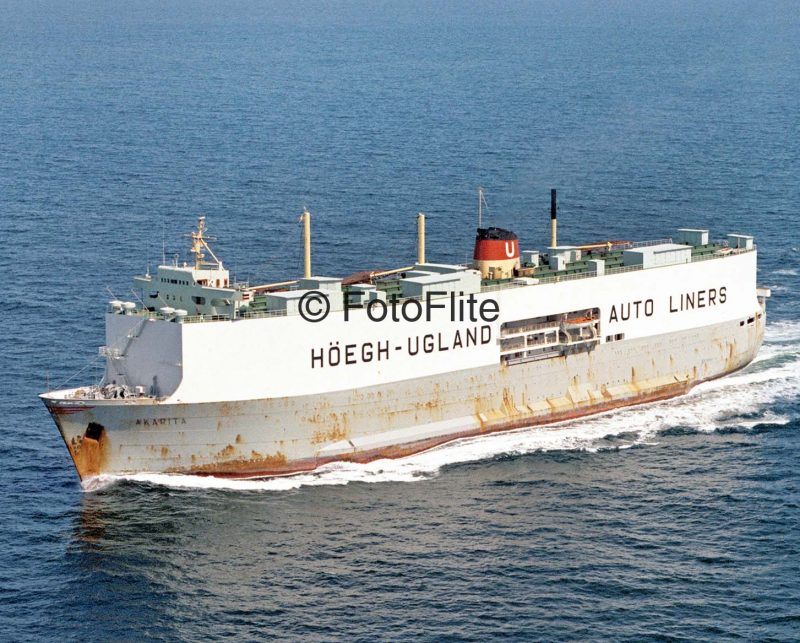
The grey and white trio of the former British passenger and cargo liners had ‘HOEGH-UGLAND AUTO LINERS’ emblazoned on the upper white parts of both sides of their hulls, and were used on a worldwide network connecting European, Japanese and American car manufacturers with their customers. Cars were loaded at Nagoya and Yokohama for Antwerp, Amsterdam, Emden and Bremerhaven, returning east with a wide range of European cars. Italian Fiat cars were transported from Savona to Jeddah, or to Houston in Texas, while American cars were loaded in the U.S. Gulf and Western coast ports for a Pacific crossing to Japan and Korea.
Hoegh Transit was renamed Hoegh Trotter (top) in June 1972 when her conversion was completed at Rijeka. The trio gained the ‘HUAL’ prefix in 1977 becoming Hual Trotter, Hual Traveller and Hual Akarita (above), but resumed their shorter names in 1980 when registered under the Ace Automobile Company of Liberia. However, their disadvantage of being side loaders was restricting their commercial ability with many quarter deck ramp stern loaders in service by the end of 1981. All three were sent to Kaohsiung for breaking up over a three month period, with Akarita, the former Amazon, the last to arrive at Kaohsiung in January 1982.
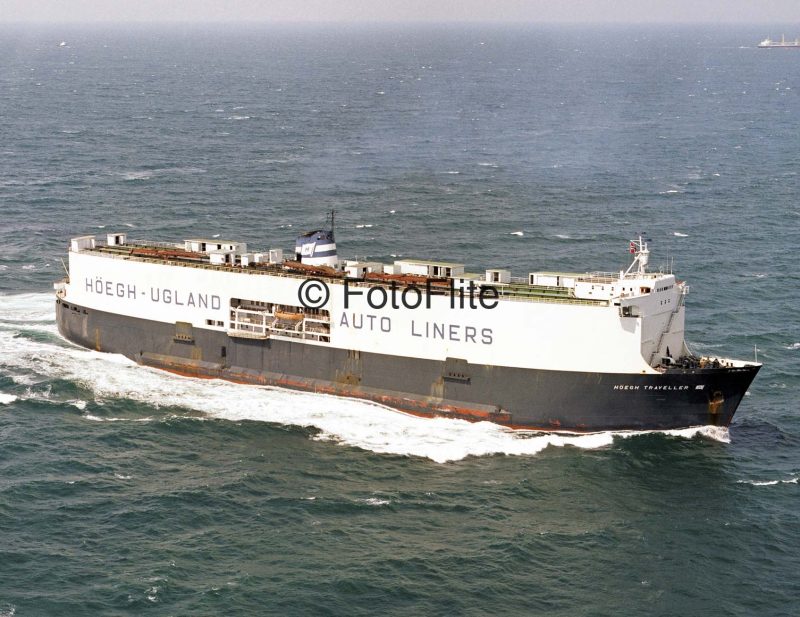
Postscript
‘The Three Graces’ were commercially successful in their second career as car carriers, but not in their first career as liners, barely covering their operating costs and never recouping their building costs. One has to question why they were built at all at such a late stage in the development of the combined passenger and cargo ship.
Financial common sense finally returned to the directors of Furness, Withy & Co. Ltd. in the cuts of November 1970 and the three ‘white elephants’ were sold on for conversion into car carriers. The handsome appearance of the trio could not compensate for the financial losses made during rapid changes in ship types and trades in the 1960s. Whereas in the 1950s, passenger ships of all types carried over three times the number of passengers using air travel, it was a very different matter in the 1960s, with few deep-sea passengers after the first flight in 1964 of the first wide bodied aircraft, the Boeing 747 ‘Jumbo’ jet.
Royal Mail Line suffered four years of big financial losses after 1964, and virtually disappeared into the Furness Withy Group in 1972, resurfacing again in 1980 when the whole group was sold off to C. Y. Tung of Hong Kong.
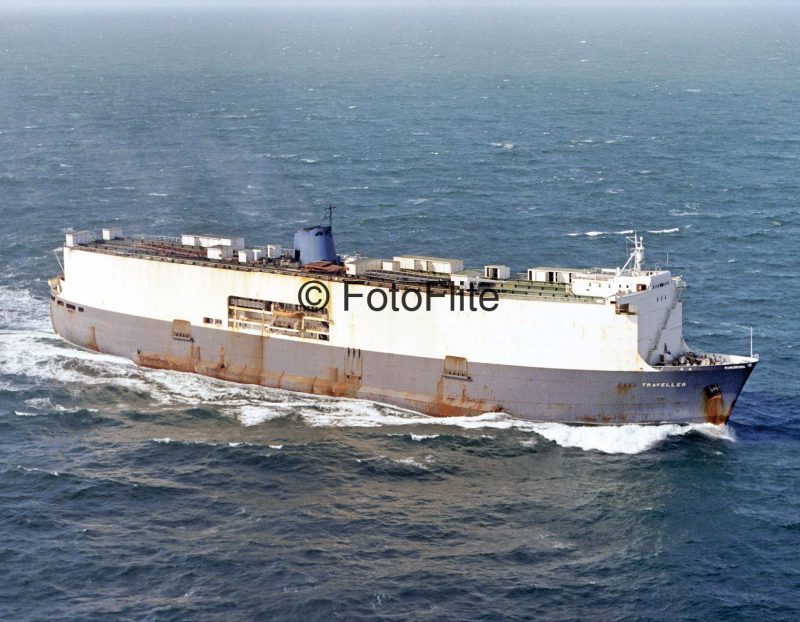
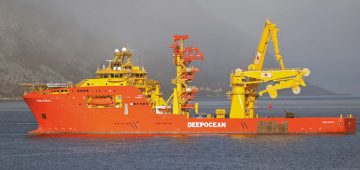



Comments
Sorry, comments are closed for this item